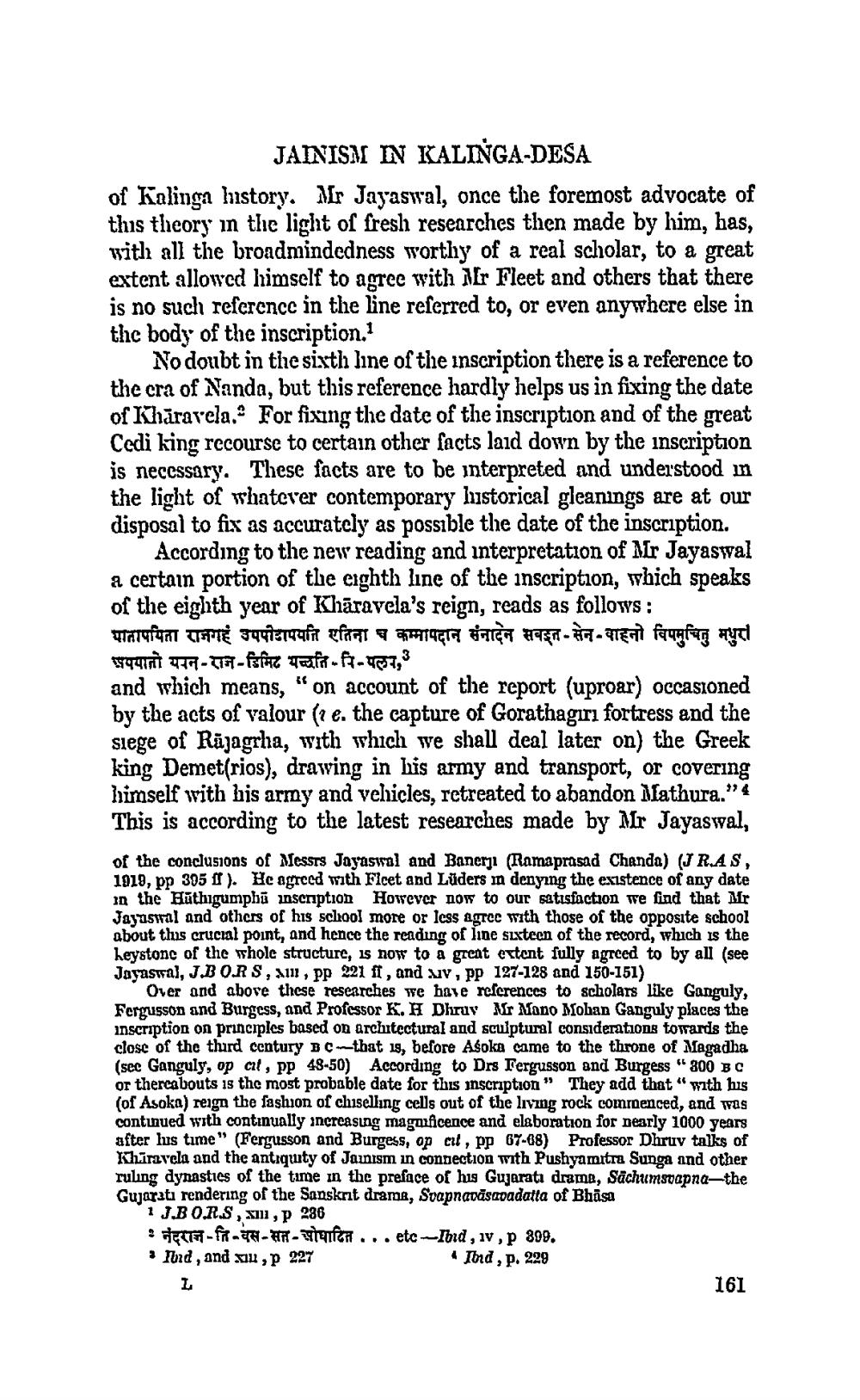________________ JAINISM IN KALINGA-DESA of Kalinga hustory. Mr Jayaswal, once the foremost advocate of this theory in the light of fresh researches then made by him, has, with all the broadmindedness worthy of a real scholar, to a great extent allowed himself to agree with Mr Fleet and others that there is no such reference in the line referred to, or even anywhere else in the body of the inscription. No doubt in the sixth line of the inscription there is a reference to the cra of Nanda, but this reference hardly helps us in fixing the date of Kharavela.. For fixing the date of the inscription and of the great Cedi king recourse to certain other facts laid down by the inscription is necessary. These facts are to be interpreted and understood in the light of whatever contemporary listorical gleanings are at our disposal to fix as accurately as possible the date of the inscription. According to the new reading and interpretation of Mr Jayaswal a certain portion of the eighth line of the inscription, which speaks of the eighth year of Kharavela's reign, reads as follows: पातापयिता राजगह उपपोडापयति एतिना घ कम्मापदान संनादेन सबइन - सेन - वाहनो विपमुचितु मधुरते अपयातो यान-राज-डिमिट यच्चति-नि-पलर, and which means," on account of the report (uproar) occasioned by the acts of valour (e. the capture of Gorathagiri fortress and the siege of Rajagrha, with which we shall deal later on) the Greek king Demetrios), drawing in his army and transport, or covering himself with his army and vehicles, retreated to abandon Mathura." This is according to the latest researches made by Mr Jayaswal, of the conclusions of Messrs Jayaswal and Banerji (Ramaprasad Chanda) (JRAS. 1019, pp 305 I). He agreed with Ficet and Luders in denying the existence of any date In the Fathugumphu inscription However now to our satisfaction we find that Mr Jayaswal and others of his school more or less agree with those of the opposite school about tins crucial point, and hence the reading of line sixteen of the record, which is the heystone of the whole structure, is now to a great extent fully agreed to by all (see Javaswa), J.BORS, X111, pp 221 ff, and wv, pp 127-128 and 150-151) Over and above these rescarches we have references to scholars like Ganguly, Fergusson and Burgess, and Professor K. H Dhruy Mr Mono Mohan Ganguly places the inscription on principles based on architectural and sculptural considerations towards the close of the third century BC--that 19, before Asoka came to the throne of Magadha (sec Ganguly, opal, pp 48-50) According to Drs Fergusson and Burgess "300 BC or thereabouts is the most probable date for this inscription" They add that with bus (of Asoka) reign the fashion of chiselling cells out of the livmg rock commenced, and was continued with continually increasing magazficence and elaboration for nearly 1000 years after hus time" (Fergusson and Burgess, op cu , pp 67-68) Professor Dhruv talks of Khiravela and the antiquity of Jainism in connection with Pushyamutra Sunga and other ruling dynasties of the time in the preface of his Gujarata druma, Sachumstapna-the Gujarati rendering of the Sanskrit drama, Svapnavasapadatta of Bhasa 1 J.BO.R.S, XI, p 236 : H TTTT-fit- T-VIETC ... etc Ibid, wv, p 809. Ind, and 12, p 227 Ind, p. 229 161




